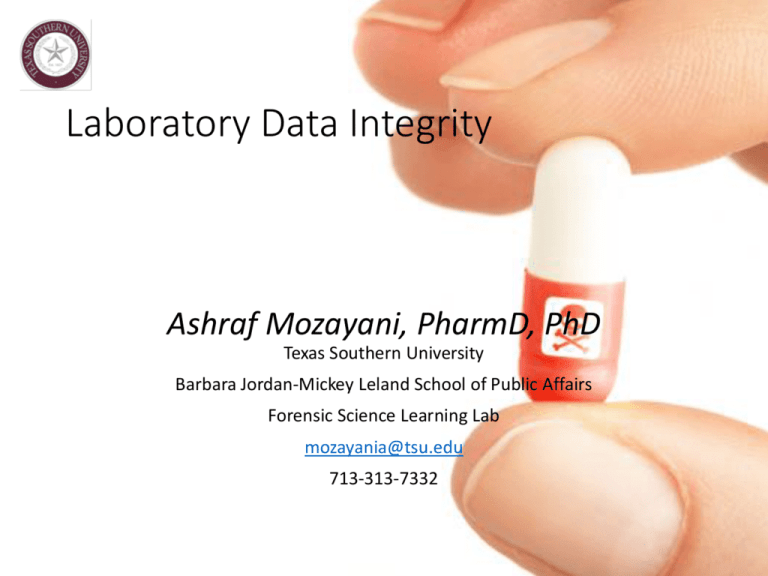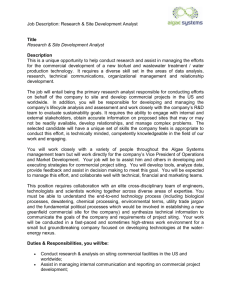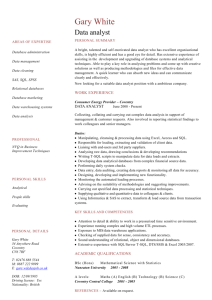Laboratory Data Integrity
advertisement

Laboratory Data Integrity Ashraf Mozayani, PharmD, PhD Texas Southern University Barbara Jordan-Mickey Leland School of Public Affairs Forensic Science Learning Lab mozayania@tsu.edu 713-313-7332 Objectives • Terminology associated with data integrity and data manipulation • Why should we have a Plan to prevent and detect data manipulation/fraud? • Situation that contribute to unethical behavior • Steps to add to detect/avoid data manipulation What is Data Integrity? Data that follows: Ethical Standards Be Acceptable in Scientific Community Be Traceable Be Defensible Terms Laboratory fraud: The falsification of analytical and quality assurance results, where failed method requirements are made to appear acceptable during reporting: Sampling Receipt, Preparation, Analysis Report writing Testifying Terms Intentional misrepresentation of lab data to hide existing or potential problems. Intent to deceive – making data look better than it really is. Dry Labbing – Reporting data for samples or procedures not actually analyzed or performed. Data deletion – removal of bad/undesirable data. Backlogging – In this context, is the entry of data into a laboratory document at a time later than the time indicated on the document Time Travel- Changing times and dates Why Should We Have A Plan? When it happens it causes : Tainting our Lab Staff Distrust by our Clients Cost us Ruin Careers Root Causes that Might Contribute to Unethical Behavior Analyst Lack of Knowledge of testing Lack of understanding the impact Lack of courage Desire for perfect record To complete cases quickly in an effort to meet deadlines Root Causes that Might Contribute to Unethical Behavior Management Ineffective Oversight Impractical Expectation Emphasis on Production over Quality Situations that Might Contribute to Laboratory Fraud To encourage boosting productivity with obtaining better merit increases or bonuses Conflict of interest with regards to a case Lack of factual/ thorough technical and administrative review Examples of Improper Lab Practices PT Batch QC Blank Testimony The Good News The forensic scientists are good at what they do however we need to address this perceived problem: realize that NO system is error-free design and implement a program that ACTIVELY looks for weak spots and corrects them And this leads to a better system – never perfect, but always better. Suggestions to improve Data Integrity!$$$ Laboratory Data Integrity Policy A systematic approach by laboratory to assure: Accurate data reflecting the test follows: Analysis using accepted scientific practice and principles Produce data that are traceable and defensible Bias free environment Ethical Professional Comply with all regulations associated with tasks, responsibilities, testimonies Data Integrity Foundation Thorough training the staff Monitoring Confidential reporting Investigation Correction Staff Training Training Program All analysts should be competency tested Prior qualification and authorization should be required to perform casework Mock Trials should be conducted Court Testimony Evaluation should be performed for testifying analysts Mandatory Ethics Training of Staff Certification Monitoring Data Integrity Staff Analytical Instruments Testing Processes Oversight and Review Monitoring Data Integrity: Staff Experienced data reviewers Thorough data review by outside expert Including chain of custody, time stamps, signatures, and an evaluation of control data Monitoring of computer updates Random, periodic observation Blind samples Detailed review of each analyst data Monitoring Data Integrity: Instrumentation Analytical Instrumentation Preparation of the sample and operation of the instrument should be performed by different individuals Instrument maintenance should be performed by individuals other than the analyst if it is possible Calibration and tuning of instruments should be performed by an individual other than the analyst. All operations of the instrument should be recorded by the operator and reviewed by a qualified reviewer prior to release of the final report All tuning, calibration and run data should be stored as PDF files immediately upon generation Monitoring Data Integrity – The Testing Process Testing Process Batching: multiple people work on a case and multiple cases should worked together Implementing the use of unique barcode on all samples Internal Chain of Custody: should be verified to track the evidence. Everyone should be indicated on the chain of custody Log Sheets, Derivative Evidence Log, and paper trail in case files 100 % Technical Reviews/Admin Reviews on all cases Taking photographs of evidence before and after sampling Photographing all subjective tests like microscopic tests , color tests Data Integrity Standard Operating Procedure- Purpose: to describe the laboratory’s data integrity system to emphasize the importance of integrity in the performance of all analytical work to acquire the commitment of laboratory staff to the principle that all analyses shall be performed in a controlled and documented manner to confirm that laboratory staff consistently meet the specific ethical requirements defined in this data integrity plan. Summary Dry-labbing, back filling or data manipulation/fraud is not wide spread It can happen in any laboratory with any analyst Learn from misfortune of other labs Have a strong Data Integrity Policy Summary All these programs require selfassessment A painful process, but necessary if we want to improve This is NOT about not trusting our colleagues. This IS about improving our system Thank you for your time. mozayaniA@tsu.edu 713-313-7332






